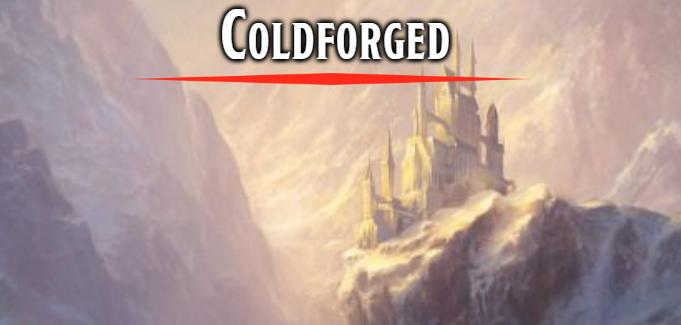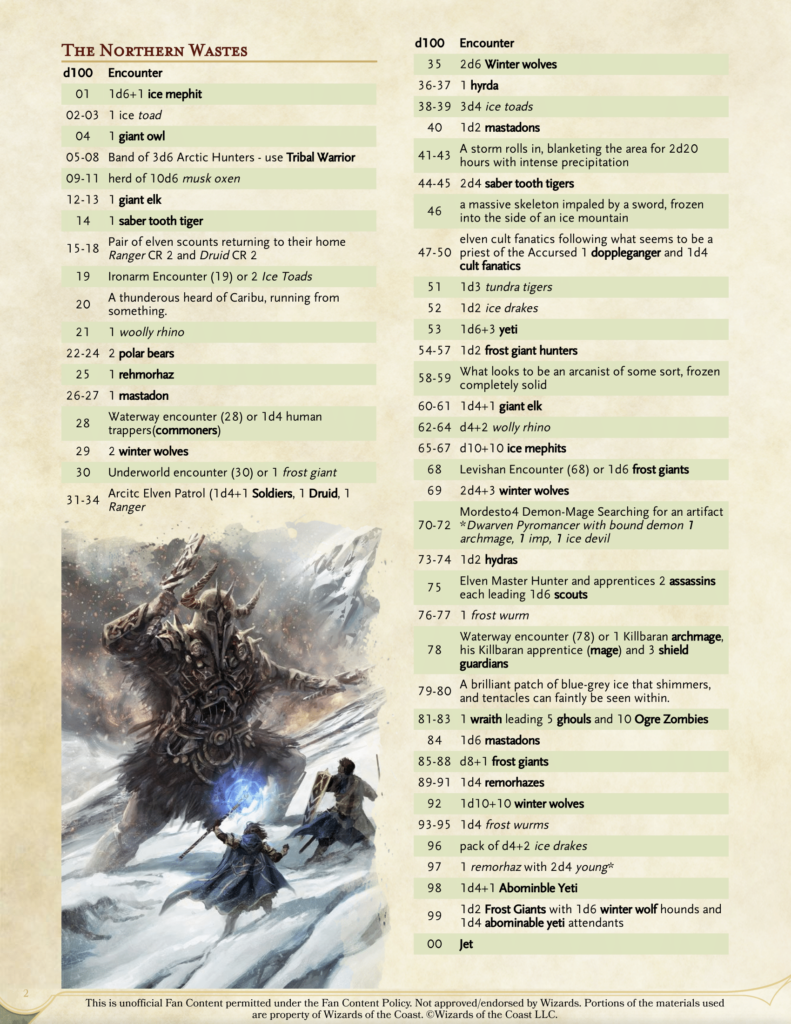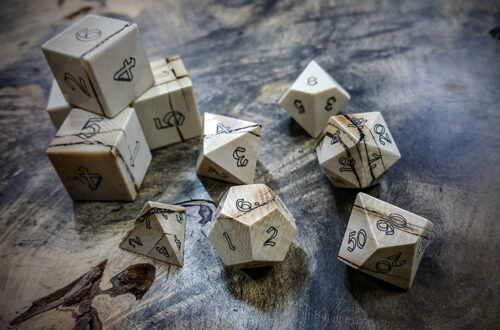
Coldforged: Building Encounter Tables
Each Thursday this year, I focus on a different aspect of the world I’ve created and played D&D in for over 20 years, in the hopes of honing the ideas and cementing enough in place to settle the world in my own mind. This week I want to look at the strange and difficult complications, as well as the awesome benefits that come from building random encounter tables.
Table Basics
There is an entire section in the DMG about creating random encounter tables, what they should be, and how they should work. It is a really helpful section in building a random encounter for a small or local area, but it’s fairly limited in practice, as well as providing a pretty sub-optimal version of an encounter table using a d12+d8 to generate a strange and bizarre curve.
In Xanathars, the encounter tables are fairly interesting. unlike the method that they describe in the DMG, which has a small cluster of encounters but spans a very wide level range, they have a tighter level range, equating to the tiers of play, but a much broader selection of monsters. Instead of a d12+d8 to give a 20 result spread, they use a d100.
Each of these different methods creates a very different random experience. If you travel long enough in the 20 result area, you’re likely to encounter the same, central curved creatures, giving the results a fairly consistent and through feel. If you travel around the d100 area, you’re likely to encounter a much broader swath of creatures, creating a more thrilling set of encounters, but likely much less consistent. Both of these are fine methods, and when I went to make my own, I combined the two in my own way.
Creature Flavor
The basics of a random encounter table are pretty simple, to me: It is to provide a quick, if not always randomly chosen, list of creatures that are possible for the area. To give an idea to someone looking at the list as to what could, and maybe should, be found in the area. An area that is fairly untamed will have lots of beasts, maybe some of the more evil humanoids, and a couple of powerful monsters. A location that is in the middle of a fairly settled and populated region, however, would have a very different encounter table.
It is extremely important to maintain a pretty solid continuity of theme when you’re building the tables. You don’t need to stick to it completely, but much like the creatures that are conspicuously absent from the table – the creatures that stick out as strange will stick out strongly and make a big difference. If the wild lands area fill of giant boars and spiders with a fairly common orc theme has a polar bear, there is going to be some really interesting story surrounding it, and the players are likely to take it as some hint or trail that they need to follow, possibly leading them down a trail to a new adventure or a different path than was intended.
With these thoughts in mind, I wanted to build an encounter table that encompassed a single area but was broad enough to cover every level of play. This leads me to create at 1d100 chart, but one that had every level of play on it, giving the world a natural, deadly feel that imparts the very strong possibility of running into things not in your challenge range. This gives a variety of opportunities beyond the simple combat encounter. Level 16 characters encountering a hunting part of half a dozen orcs have many different implications than a party of 1st level characters encountering the same.
With the Plan for how to proceed solidly in place, for now, I break the continent into a number of different regions, each of which gets its own random encounter chart:
- The Northern Wastes
- The Forest of Levisha
- The Thraxian and Northern Forests
- Northern Scrub Lands
- Imerian Peninsula
- Southern Forests
- The Ironarm Mountains
- The Drimmak Mountains
- The Great Swamp
- Toldiri Hills
- Waterways
- Open Ocean
- The Underworld
Each of these different areas would get their own chart, as each was a separate and interesting environment with its own population of monsters and humanoids. I then took to the Monster Manual and my own imagination to write up a list of creatures for each area, and rate them by their commonality, with rare, uncommon, and common type creatures so that I understood how often I wanted to use that creature within the chart.
Following this, though, I realized that I wanted to try and get crossover creatures between regions, to create bleed between the areas and make the whole setting feel like a single continual whole instead of something that is disparate parts. So, I took a single encounter number from each of the first three tiers of play, and labeled it as a “crossover encounter, and made sure that none of these crossover encounters overlapped. So, I have 27, 57, and 77 as crossover encounters in the Northern Wastes. These are specifically tailored to be encounters that will make sense, at the tier of play they are in, in another area. 1 Mastodon, 1d2 Frost Giant Hunters, and a Frost Worm. Each of these can make sense in a nearby area. After that, I went and picked which regions could have these crossover encounters happen in them. For the Northern Wastes encounters, I knew that the Ironarm Mountains, the Waterways (being the coast or rivers), and the forest of Levisha could all handle these encounters. On each of those charts I chose which tier I wished the crossover in, and made a note on that specific roll – See Northern Wastes, and gave the encounter number to cross-reference, which is the number rolled already, but allows variance in the future. I also gave another encounter that could be used instead, in case the area they were in didn’t call for a crossover.
once all of that was done, I decided what tier area that each was, and expanded the number of encounters at that location to accommodate a stronger than average presence of in-tier encounters.
In addition to the monsters, I included some “non-monster” encounters to fill out the chart with things that are interesting, and that with a little bit of creativity could become side quests or exciting moments.
At this point, all that is left is to fill in monsters, and that is no small feat. These encounter tables are large, on purpose, as they are meant to be used for every adventure in the area and span the entire gamut of encounters. The work is worth it, though, as I end up with a very characterful, encounter chart that really fits, or creates, as I’m not sure which comes first, the feel of the region.
Lastly, as I’ve been talking this whole time about it, I’ll give you a sample of the Northern Wastes. There are two types of creatures, those that are in bold, which are standard monsters anyone can use, and those in italics, which it looks like I’ll have to create. I’m still not done with the tables – I’ve only made it halfway through since the middle of April.

Until next time!


